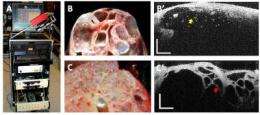Near-infrared imaging system shows promise as future pancreatic cancer diagnostic tool

A team of researchers from four Boston-area institutions led by Nicusor Iftimia from Physical Sciences, Inc. has demonstrated for the first time that optical coherence tomography (OCT), a high resolution optical imaging technique that works by bouncing near-infrared laser light off biological tissue, can reliably distinguish between pancreatic cysts that are low-risk and high-risk for becoming malignant. Other optical techniques often fail to provide images that are clear enough for doctors to differentiate between the two types.
To test the diagnostic potential of OCT imaging, researchers used the technique to examine surgically removed pancreatic tissue samples from patients with cystic lesions. By identifying unique features of the high-risk cysts that appeared in the OCT scans, the team developed a set of visual criteria to differentiate between high and low risk cysts. They then tested the criteria by comparing OCT diagnoses to those obtained by examining thin slices of the pancreatic tissue under a microscope. Their results, described in the August issue of the Optical Society's (OSA) open-access journal Biomedical Optics Express, showed that OCT allowed clinicians to reliably differentiate between low-risk and high-risk cysts with a success rate close to that achieved by microscope-assisted examinations of slices of the same samples.
Future studies by the research team will focus on improving imaging resolution to further differentiate between solid lesions and autoimmune pancreatitis, and test this technology in vivo. They recently received FDA approval for testing this technology in human patients by using an OCT probe small enough to be inserted into the pancreas through a biopsy needle, which will be guided into suspect masses in the pancreas by endoscopic ultrasound imaging. A pilot clinical study is planned to start within the next couple of months. If in vivo data will prove reliable differentiation between the two types of cysts, a study in a larger number of patients will be planned, contingent on NIH funding and FDA approval.
More information: Paper: "Differentiation of pancreatic cysts with optical coherence tomography (OCT) imaging: an ex-vivo pilot study," Biomedical Optics Express, Iftimia et al., Vol. 2, Issue 8, pp. 2372-2382. www.opticsinfobase.org/boe/abs … cfm?URI=boe-2-8-2372
Provided by Optical Society of America

















